Faraday: Unification of Paradigm
 Michael Faraday: Electricity
Michael Faraday: Electricity
Electracy (the term) joins electricity and trace to name the digital apparatus. Michael Faraday made a major contribution to the science and technology of electracy (he is considered to be the first electrical engineer). His work exemplifies a principle of heuretics regarding the transdisciplinary character of creativity. His discovery of the unity of electricity and magnetism was guided by a themata (Holton)–the unification of all forces in the cosmos–which directed his empirical work. The following passage holds a place for further discussion.
But Faraday was not wholly without philosophical intent. As a young man, he became enamored of a version of Kant’s philosophy extolled with great force by the poet Samuel Taylor Coleridge. It was based on the universe being filled with a web of attractive and repulsive forces, convertible one into the other, with their total being conserved. At the bottom, this cosmic web was woven by God. Everything is here in nascent form, including forces to fill the vacuum, as well as conservation of energy. Faraday was particularly taken by Coleridge’s statement that “Things identical must be convertible.” He believed a relation between electrical and magnetic forces had to exist. As Faraday’s biographer L. Pierce Williams writes, “It was the conviction that forces were inherently identical and convertible that inspired Michael Faraday during the major portion of his scientific career.” (Arthur I. Miller, Insights of Genius: Imagery and Creativity in Science and Art, MIT Press, 2000: 102).
The immediate point to register is to extend the unification of forces (energy) into the cultural and human realm, with respect to the axis of attraction-repulsion as organizing electracy, including the libidinal economy of desire. An abstract of an essay by Williams notes a further correlation of Faraday with the metaphysics structuring konsult as pedagogy: Capabilities.
This chapter focuses on epistemology and the experimental methods used by Michael Faraday. The methods of all sciences are identical. These methods include observation of facts, comparison and classification of facts, deduction of facts, and verification of results. Science guided Faraday throughout his life. It must have infuriated his contemporaries that the foremost experimentalist of the nineteenth century rejected the prevalent theories of experimental method. In fact, Faraday’s scientific career was founded upon a rather simple, but fundamentally important, concept of the mind and its faculties. The mind consists of basically three faculties—the senses, the judgment, and the imagination. The senses provide the mind with the raw material for its operations but this is not automatic or mechanical. The mind has to be carefully trained in the reception of sense impressions or else it will err in its judgments. (“Epistemoloogy and Experiment: the Case of Michael Faraday,” Studies in Logic and the Foundations of Mathematics, Vol 49, 1968).

 –How an Image becomes Wide. Koren demonstrates how a detail of the world is selected as a vehicle for a poetic image: for example, a worn shingle on an old hut, with a streak of rust descending from an iron nail. The tenor (theme) of this vehicle is coded in Japanese traditional culture, relative to the wisdom metaphysics of Buddhism, to express an existential insight into time and entropy known as wabi-sabi. “Wabi-Sabi can be called a ‘comprehensive’ aesthetic system. Its world view, or universe, is self-referential. It provides an integrated approach to the ultimate nature of existence (metaphysics), sacred knowledge (spirituality), emotional well-being (state of mind), behavior (morality), and the look and feel of things (materiality)” (Koren, 41). The instruction was not to seek Wabi-Sabi in one’s own experience, but the equivalent, the mood and atmosphere, to find one’s personal version of what was modeled in Japanese tradition. The folk traditions of Blues into Jazz in global Creole syncretism (mufarse into tango, saudade into samba) is central to the thymotic and erotic dimension of world materialized in digital electracy. Koren’s analysis demonstrates how to expand the two-part vehicle and tenor of image into a six-part inventory. Students generated their emblems productive of wide image by answer six questions posed by Koren: three for vehicle; three for tenor. The three questions addressing tenor (themata) are the same three articulated in the catechism of modernism, directing theopraxesis. One implication, to be developed further, is that the system of capabilities is not confined to the Western Tradition, but functions globally across cultures and civilizations.
–How an Image becomes Wide. Koren demonstrates how a detail of the world is selected as a vehicle for a poetic image: for example, a worn shingle on an old hut, with a streak of rust descending from an iron nail. The tenor (theme) of this vehicle is coded in Japanese traditional culture, relative to the wisdom metaphysics of Buddhism, to express an existential insight into time and entropy known as wabi-sabi. “Wabi-Sabi can be called a ‘comprehensive’ aesthetic system. Its world view, or universe, is self-referential. It provides an integrated approach to the ultimate nature of existence (metaphysics), sacred knowledge (spirituality), emotional well-being (state of mind), behavior (morality), and the look and feel of things (materiality)” (Koren, 41). The instruction was not to seek Wabi-Sabi in one’s own experience, but the equivalent, the mood and atmosphere, to find one’s personal version of what was modeled in Japanese tradition. The folk traditions of Blues into Jazz in global Creole syncretism (mufarse into tango, saudade into samba) is central to the thymotic and erotic dimension of world materialized in digital electracy. Koren’s analysis demonstrates how to expand the two-part vehicle and tenor of image into a six-part inventory. Students generated their emblems productive of wide image by answer six questions posed by Koren: three for vehicle; three for tenor. The three questions addressing tenor (themata) are the same three articulated in the catechism of modernism, directing theopraxesis. One implication, to be developed further, is that the system of capabilities is not confined to the Western Tradition, but functions globally across cultures and civilizations. –Poetics: Image expanded into Emblem. The expanded image consists of two registers: material; metaphysical. Working with the narratives generated in composition of mystory, students must commit to one pedagogical object (magic tool), some detail found in at least one of the diegesis of the popcycle, to serve as logo or brand icon for the wide image. In Ulmer’s case (Noon Star), the repeating detail (like the dogs repeating in Momaday’s section III) was a five-pointed star: Family memory (the red star on his sheet music of the march, Garry Owen; Entertainment mythology (the film High Noon, Gary Cooper as Will Kane, discarding his sheriff’s star in the dirt after the gun fight); Community history (“General” Custer’s badge of rank, and Indian name, Son of the Morning Star). The three material questions are: 1) what is the prop/ icon? Ulmer chose the tin star sheriff’s badge to represent this materiality. 2) What are its attributes? (what mood or atmosphere is expressed that distinguishes this icon from its archetype, configuring it specifically for me. The context of High Noon star thrown in the dirt expresses rejection and disgust with the hypocritical authority symbolized in the badge. 3) Archetype: what is the conventional meaning associated with this icon in the archive? (the five-pointed star has an extensive presence throughout many cultures).
–Poetics: Image expanded into Emblem. The expanded image consists of two registers: material; metaphysical. Working with the narratives generated in composition of mystory, students must commit to one pedagogical object (magic tool), some detail found in at least one of the diegesis of the popcycle, to serve as logo or brand icon for the wide image. In Ulmer’s case (Noon Star), the repeating detail (like the dogs repeating in Momaday’s section III) was a five-pointed star: Family memory (the red star on his sheet music of the march, Garry Owen; Entertainment mythology (the film High Noon, Gary Cooper as Will Kane, discarding his sheriff’s star in the dirt after the gun fight); Community history (“General” Custer’s badge of rank, and Indian name, Son of the Morning Star). The three material questions are: 1) what is the prop/ icon? Ulmer chose the tin star sheriff’s badge to represent this materiality. 2) What are its attributes? (what mood or atmosphere is expressed that distinguishes this icon from its archetype, configuring it specifically for me. The context of High Noon star thrown in the dirt expresses rejection and disgust with the hypocritical authority symbolized in the badge. 3) Archetype: what is the conventional meaning associated with this icon in the archive? (the five-pointed star has an extensive presence throughout many cultures).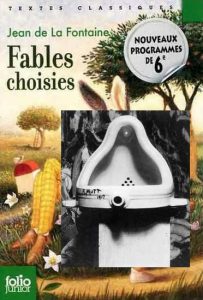 –Fable: What resources are available for inquiry and expression in the conditions after Nietzsche, the history of an error, after the simultaneous withdrawal of the true world and the apparent world along with it? The time is noon (the shortest shadow). What remains is fable, Nietzsche said. What are the possibilities of fable as genre? Duchamp improvised one approach, perhaps not even yet fully appreciated. His Readymades are fables, albeit weak (faible) fables, in that they provide the illustrations only (the emblems, impresas). He intimated his variation on the mode with his most notorious instance, whose title “Fountain” translates “La Fontaine,” antonomasia between common and proper noun, evoking the name of the author of many fables in the common “fountain,” itself a euphemistic title for a urinal. Ulmer’s collage of the urinal with a cover of La Fontaine’s book make the joke explicit. Duchamp’s commitment to the punning bachelor machine logic central to modernism is well known. He acknowledged his attendance at a performance of a stage adaptation of Raymond Roussel’s 1910 novel Impressions of Africa as a turning point in his career (Roussel’s method of composition used generative puns). It has been suggested that some of the Readymades at least are comments on dreams described in Freud’s Interpretation of Dreams, hence that they use rebus methods (visualizations evoking words). Freud noted, for example, that many dreams are triggered when sleepers experience the need to urinate (the dream allows sleep to continue briefly). The text of the fabled fountain is provided by its history, being as it is the most influential (if not the “best”) art work of the twentieth century, including its status as a prank, and all the manipulations Duchamp performed to put the image of La Fontaine into circulation, recorded in Thierry De Duve’s Kant After Duchamp. What is the moral of the readymade fable?
–Fable: What resources are available for inquiry and expression in the conditions after Nietzsche, the history of an error, after the simultaneous withdrawal of the true world and the apparent world along with it? The time is noon (the shortest shadow). What remains is fable, Nietzsche said. What are the possibilities of fable as genre? Duchamp improvised one approach, perhaps not even yet fully appreciated. His Readymades are fables, albeit weak (faible) fables, in that they provide the illustrations only (the emblems, impresas). He intimated his variation on the mode with his most notorious instance, whose title “Fountain” translates “La Fontaine,” antonomasia between common and proper noun, evoking the name of the author of many fables in the common “fountain,” itself a euphemistic title for a urinal. Ulmer’s collage of the urinal with a cover of La Fontaine’s book make the joke explicit. Duchamp’s commitment to the punning bachelor machine logic central to modernism is well known. He acknowledged his attendance at a performance of a stage adaptation of Raymond Roussel’s 1910 novel Impressions of Africa as a turning point in his career (Roussel’s method of composition used generative puns). It has been suggested that some of the Readymades at least are comments on dreams described in Freud’s Interpretation of Dreams, hence that they use rebus methods (visualizations evoking words). Freud noted, for example, that many dreams are triggered when sleepers experience the need to urinate (the dream allows sleep to continue briefly). The text of the fabled fountain is provided by its history, being as it is the most influential (if not the “best”) art work of the twentieth century, including its status as a prank, and all the manipulations Duchamp performed to put the image of La Fontaine into circulation, recorded in Thierry De Duve’s Kant After Duchamp. What is the moral of the readymade fable? –Martin Kippenberger, “Rameau’s Nephew,” 1988
–Martin Kippenberger, “Rameau’s Nephew,” 1988 Catechism: Wide Image. The catechism of modernism (drawing on the Western Tradition) is articulated in Kant’s philosophy and Gauguin’s painting. The answers to the questions are specific to each person, and are generated during the composition of the wide image. Several posts are required to unfold this poetics, by means of which egents learn to actualize in their own projects the intelligence potential (latent) in the cultural archive. This archive in its global version functions for electracy the way Avatar functioned for orality: source of absolute knowledge (the project of Avatar Emergency was learning to receive this communication of Avatar). One of the first things that happens in transition from one apparatus to another is the mise en machine of the previous apparatus. As McLuhan observed, the content of the new medium is the old medium (literacy put oral mythologies into writing; electracy digitized the libraries). The remainder of the apparatus epoch is devoted to invention and diffusion throughout society of the new metaphysics (operating practices).
Catechism: Wide Image. The catechism of modernism (drawing on the Western Tradition) is articulated in Kant’s philosophy and Gauguin’s painting. The answers to the questions are specific to each person, and are generated during the composition of the wide image. Several posts are required to unfold this poetics, by means of which egents learn to actualize in their own projects the intelligence potential (latent) in the cultural archive. This archive in its global version functions for electracy the way Avatar functioned for orality: source of absolute knowledge (the project of Avatar Emergency was learning to receive this communication of Avatar). One of the first things that happens in transition from one apparatus to another is the mise en machine of the previous apparatus. As McLuhan observed, the content of the new medium is the old medium (literacy put oral mythologies into writing; electracy digitized the libraries). The remainder of the apparatus epoch is devoted to invention and diffusion throughout society of the new metaphysics (operating practices).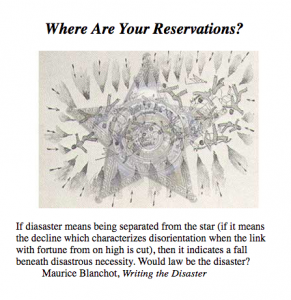 –Emblem. The translation of mystory into wide image is mediated by emblematics. The emblem (having the same structure as a generic advertisement), considering its historical relationship with allegory, expresses in condensed form the image of wide scope ( sinthome, Lacan) that emerges in the making of a mystory (it embodies the pattern of signifiers that repeat when the makers situation is mapped across the popcycle). Studio and Textshop exercises explore the form, including its history from its introduction in the Renaissance through to contemporary advertising. An advantage of the form is just this combination of archival presence and pop familiarity. Ulmer designed this emblem based on his mystory: Motto is “pithy,” aphoristic, allusive, to produce an evocative connotation when combined with the picture. The epigraph is informational, clarifying what is suggested in the motto-picture juxtaposition.
–Emblem. The translation of mystory into wide image is mediated by emblematics. The emblem (having the same structure as a generic advertisement), considering its historical relationship with allegory, expresses in condensed form the image of wide scope ( sinthome, Lacan) that emerges in the making of a mystory (it embodies the pattern of signifiers that repeat when the makers situation is mapped across the popcycle). Studio and Textshop exercises explore the form, including its history from its introduction in the Renaissance through to contemporary advertising. An advantage of the form is just this combination of archival presence and pop familiarity. Ulmer designed this emblem based on his mystory: Motto is “pithy,” aphoristic, allusive, to produce an evocative connotation when combined with the picture. The epigraph is informational, clarifying what is suggested in the motto-picture juxtaposition.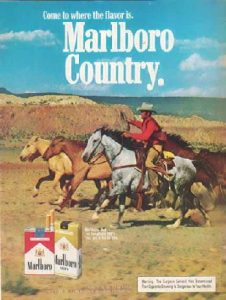 –Advertisement.The Marlboro Cowboy
–Advertisement.The Marlboro Cowboy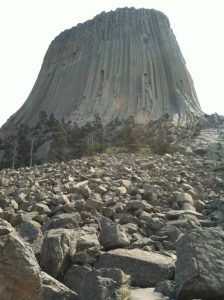 The Way to Rainy Mountain. Son of a White mother and Kiowa father, Momaday was raised on a reservation. His novel House Made of Dawn won a Pulitzer Prize in 1969. His autobiographical The Way to Rainy Mountain was assigned as relay modeling the micro form and overall structuring by means of signifiers repeating across levels of the popcycle. Rainy Mountain juxtaposes Kiowa myths Momaday learned from his grandmother; the actual history of the Kiowa symbolized in the myths; his personal recollections of his childhood on the reservation. The text manifests identification (with his grandmother Aho and his grandfather Mammedaty); the use of pattern (the unity of each section is created by the repetition of a detail within the exposition across the three discourses); the use of setting to express feeling (the memories of scenes from the reservation). Most important is the location of Momaday’s memories of childhood in the context of the traditional stories and actual history of his Community (Kiowa), thus bringing the three levels of his symbolic experience into contact–personal, historical, mythical (entertainment fictions in a modern point of view). The book is a collection of thirty-four three-paragraph units (plus introduction and epilogue) illustrated with drawings by Momaday’s father. Unit 3 is cited as example: the popcycle sequence is always the same: Mythology; History; Memory.
The Way to Rainy Mountain. Son of a White mother and Kiowa father, Momaday was raised on a reservation. His novel House Made of Dawn won a Pulitzer Prize in 1969. His autobiographical The Way to Rainy Mountain was assigned as relay modeling the micro form and overall structuring by means of signifiers repeating across levels of the popcycle. Rainy Mountain juxtaposes Kiowa myths Momaday learned from his grandmother; the actual history of the Kiowa symbolized in the myths; his personal recollections of his childhood on the reservation. The text manifests identification (with his grandmother Aho and his grandfather Mammedaty); the use of pattern (the unity of each section is created by the repetition of a detail within the exposition across the three discourses); the use of setting to express feeling (the memories of scenes from the reservation). Most important is the location of Momaday’s memories of childhood in the context of the traditional stories and actual history of his Community (Kiowa), thus bringing the three levels of his symbolic experience into contact–personal, historical, mythical (entertainment fictions in a modern point of view). The book is a collection of thirty-four three-paragraph units (plus introduction and epilogue) illustrated with drawings by Momaday’s father. Unit 3 is cited as example: the popcycle sequence is always the same: Mythology; History; Memory. III
III Event Gest.
Event Gest. 

 Nancy Kitchel’s “grandmother’s gesture” may be seen as a series of variations on a gesture of worry and anxiety codified in this photograph taken by Dorothea Lange as part of a New Deal project to document the misery of migrant workers, sponsored by the Farm Security Administration during the Great Depression. “Migrant Mother” is one of the most-cited pictorial images of our times.
Nancy Kitchel’s “grandmother’s gesture” may be seen as a series of variations on a gesture of worry and anxiety codified in this photograph taken by Dorothea Lange as part of a New Deal project to document the misery of migrant workers, sponsored by the Farm Security Administration during the Great Depression. “Migrant Mother” is one of the most-cited pictorial images of our times. This idea I have that the whole inside of my head resembles this landscape (flat? nothing there?), that the particular, peculiar sense of great space, isolation in space, harshness, clarity, severity, the constant transitions, shifts, reveries, the wild swings form one state to another, forms the visual, auditory, reasoning, base for thought or action. A sense that I have been formed out of the quality of the landscape, that everything unnecessary is being slowly eroded by harsher elements. And the confidence that I will survive, denuded, or that something will survive, something will never stop.”
This idea I have that the whole inside of my head resembles this landscape (flat? nothing there?), that the particular, peculiar sense of great space, isolation in space, harshness, clarity, severity, the constant transitions, shifts, reveries, the wild swings form one state to another, forms the visual, auditory, reasoning, base for thought or action. A sense that I have been formed out of the quality of the landscape, that everything unnecessary is being slowly eroded by harsher elements. And the confidence that I will survive, denuded, or that something will survive, something will never stop.” 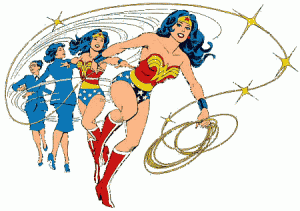 Wonder Woman
Wonder Woman